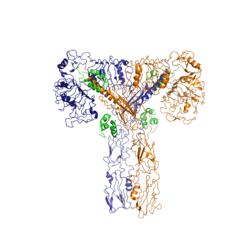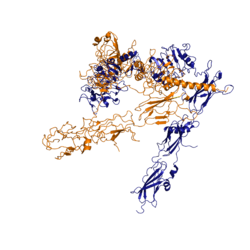Johnson's Monday Lab Sandbox for Insulin Receptor
From Proteopedia
(Difference between revisions)
| Line 5: | Line 5: | ||
==Function of the Receptor== | ==Function of the Receptor== | ||
| - | The insulin receptor binds the insulin hormone and initiates a cascade of events within the cell. The receptor resides within the [http://en.wikipedia.org/wiki/Cell_membrane plasma membrane] of insulin targeted cells. These cells are found in various organs, such as the liver, and tissues, including skeletal muscle and adipose. The insulin receptor is activated by multiple insulin molecules binding to various sites on the receptor. Once activated, the receptor serves as the gateway for the regulation of various cellular processes including glucose transport, glycogen storage, [http://en.wikipedia.org/wiki/Autophagy autophagy], [http://en.wikipedia.org/wiki/Apoptosis apoptosis], and gene expression. Additionally, problems with the insulin receptor are associated with the development of diseases such as Alzheimer's, type II diabetes, and cancer <ref name="Scapin" />. Recent structures of the insulin receptor have illustrated the large scale [http://en.wikipedia.org/wiki/Conformational_change conformational changes], initiated by insulin binding. Evaluation of the structural composition and the biochemical properties of the insulin receptor reveals details about the role of the receptor in crucial cellular processes. | + | The insulin receptor binds the insulin hormone and initiates a cascade of events within the cell. The receptor resides within the [http://en.wikipedia.org/wiki/Cell_membrane plasma membrane] of insulin targeted cells. These cells are found in various organs, such as the liver, and tissues, including skeletal muscle and adipose <ref name="Boucher" />. The insulin receptor is activated by multiple insulin molecules binding to various sites on the receptor <ref name="Uchikawa" />. Once activated, the receptor serves as the gateway for the regulation of various cellular processes including glucose transport, glycogen storage, [http://en.wikipedia.org/wiki/Autophagy autophagy], [http://en.wikipedia.org/wiki/Apoptosis apoptosis], and gene expression. Additionally, problems with the insulin receptor are associated with the development of diseases such as Alzheimer's, type II diabetes, and cancer <ref name="Scapin" />. Recent structures of the insulin receptor have illustrated the large scale [http://en.wikipedia.org/wiki/Conformational_change conformational changes], initiated by insulin binding. Evaluation of the structural composition and the biochemical properties of the insulin receptor reveals details about the role of the receptor in crucial cellular processes. |
==Insulin== | ==Insulin== | ||
The <scene name='83/839263/Insulin_molecule/3'>insulin molecule</scene> is a [http://en.wikipedia.org/wiki/Hormone hormone] made of two separate amino acid chains that are bound by multiple disulfide bonds. Insulin is synthesized and secreted from the [http://en.wikipedia.org/wiki/Pancreatic_islets islets of Langerhans] of the pancreas in response to high concentrations of glucose in the blood. Once it is secreted, insulin moves through the bloodstream and binds to unactivated insulin receptors residing in the plasma membrane. Binding of insulin to the insulin receptor is a complex process, which involves negative cooperativity among insulin molecules <ref name="Uchikawa" /> <ref name="Schäffer" /> <ref name="Meyts" />. Current hypotheses propose that the receptor is fully activated only after multiple insulin molecules are bound <ref name="Uchikawa" />. | The <scene name='83/839263/Insulin_molecule/3'>insulin molecule</scene> is a [http://en.wikipedia.org/wiki/Hormone hormone] made of two separate amino acid chains that are bound by multiple disulfide bonds. Insulin is synthesized and secreted from the [http://en.wikipedia.org/wiki/Pancreatic_islets islets of Langerhans] of the pancreas in response to high concentrations of glucose in the blood. Once it is secreted, insulin moves through the bloodstream and binds to unactivated insulin receptors residing in the plasma membrane. Binding of insulin to the insulin receptor is a complex process, which involves negative cooperativity among insulin molecules <ref name="Uchikawa" /> <ref name="Schäffer" /> <ref name="Meyts" />. Current hypotheses propose that the receptor is fully activated only after multiple insulin molecules are bound <ref name="Uchikawa" />. | ||
| Line 29: | Line 29: | ||
==Type II Diabetes== | ==Type II Diabetes== | ||
| - | Type II | + | Type II diabetes (T2D) is a chronic condition that affects 10 percent of the world's population <ref name="Boucher" />. T2D is characterized by insulin resistance and leads to high concentrations of glucose in the bloodstream. A type II diabetic produces insulin, but when the insulin molecule binds to the insulin receptor, the signal is not properly transmitted intracellularly <ref name="Boucher" />. Insulin resistance in type II diabetes is not associated with mutations of the insulin receptor gene. Mutations of the receptor gene are associated with more severe cases of insulin resistance, as seen in leprechaunism, and can prove more fatal than routine type II diabetes <ref name="Boucher" />. While type II diabetes is known to not be associated with mutations of the insulin receptor gene, the basis for insulin resistance in routine type II diabetics is complex and has not yet been explained by one particular factor. |
| + | |||
| + | There are a multitude of hypotheses which discuss the reasons for the development of type II diabetes <ref name="Boucher" /> <ref name="Franks" />. Historically, the chronic condition has been closely associated with high caloric intake and sedentary lifestyles. However, recent studies, which have evaluated the relationships between genetics and environmental factors in the development of T2D, have shown that T2D is not uniform among the population. A variety of factors may play a role in risk for T2D including gestational environment, [http://en.wikipedia.org/wiki/Human_microbiome microbiome], genetics, diet, and energy expenditure <ref name="Franks" />. Furthermore, the possible genetic or environmental factors which contribute to the development of T2D do not follow the same biochemical pathway to initiate insulin resistance. The establishment of insulin resistance is complex at both the macroscopic and molecular levels. | ||
| + | |||
| + | Within the cell, insulin resistance does not follow one pathway. Current biochemical explanations for insulin resistance include lipotoxicity, inflammation, reactive oxygen species, endoplasmic reticulum stress, and hyperglycemia <ref name="Boucher" />. Under normal conditions, the signal from the insulin receptor is transduced to the insulin receptor substrate (IRS-1) upon phosphorylation of tyrosine residues on IRS-1. In some cases of lipotoxicity, inflammation, and hyperglycemia, serine residues of IRS-1 are phosphorylated instead of tyrosine residues and the signal from the insulin receptor is no longer properly transduced. | ||
Revision as of 23:38, 19 April 2020
Insulin Receptor
| |||||||||||


